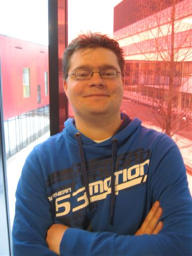Template-electrodeposited nanowires: synthesis, manipulation and application
Promotion date: 15. December 2010
Promotor: Prof.dr.ing. Dave Blank
Assistant promotor: Dr. ir. André ten Elshof
| Templated electrodeposition was used as a scalable and cost-effective manufacturing technique for nanowires and nanotubes. All processes proceeded in the confined space of membrane pores: 50 nm and 200 nm. Also, first steps were taken towards incorporations of nanowires and nanotubes on electrodes by dielectrophoresis, an important step for industry to learn and recognize the numerous possibilities for applications. Its working principle is based on an alternating electric field between two electrodes, trapping nanowires from a medium in that alternating field. Furthermore, the functionality of nanowires can be engineered. A direct application was demonstrated: to demonstrate hydrogen evolution by nanowires under UV-irradiation. In order to reach this, a segmented nanowire consisting of a silver segment and an n-type zinc oxide segment was made photocatalytic. |
Could you recall a special moment during your thesis project?
I clearly remember when I first saw the actual nanowires, while using a scanning electron microscope. By then, I used quite a rough method to harvest these wires.
This result gave me confidence to continue looking for new ways to fabricate nanowires, using nickel and gold. In the end we demonstrated segmented nanowires’ functionality was clearly defined and could be used as a catalyst, producing hydrogen even.
In what way did the thesis project change your way of working as a researcher and scientist?
Well, I am very persistent in reaching the goals that are set onto me. That helped me a lot, to come to nice results in the end. I’m striving towards perfection, whilst communicating with fellow-researchers at the same time. Also, I had a very nice time working with two master students, coming up with helpful ideas and inspiring outcomes of their research parts.
What are your future plans?
Right now, I am applying as an application engineer at a large company. I look forward to this. I imagine in industry one has to come up with results at an earlier stage then in academic research.
Did you feel part of the Mesa+ community during the project?
Very much so, indeed. Already as a student, I was using SEM, TEM and diffraction imaging. In this project I especially valued the expertise of my colleagues to prepare the samples. Scanning by optical microscopy - smartly using colour differences which indicate the presence and location of nanowires in the sample – certainly helped saving lots of time and even more costs, reducing valuable time spent at expensive apparatus.
What, do you think, is important for Mesa+ to stay successful?
In order to make sure cash flow is generated in the future, the foundry service should remain intact, in my opinion. In this construction, companies can commercially make use of the specialized apparatus available in the cleanroom.
Also, I would recommend the use of common materials in favour of rare exotic materials, as they are not as widely available.
Finally, in order to improve the acceptance of nano technology, serious research has to be done in order to verify that free nano particles are not hazardous for public health, even if examinations using animals are necessary. Also instruction and communication to the public should be clear and frank, from the very beginning.

